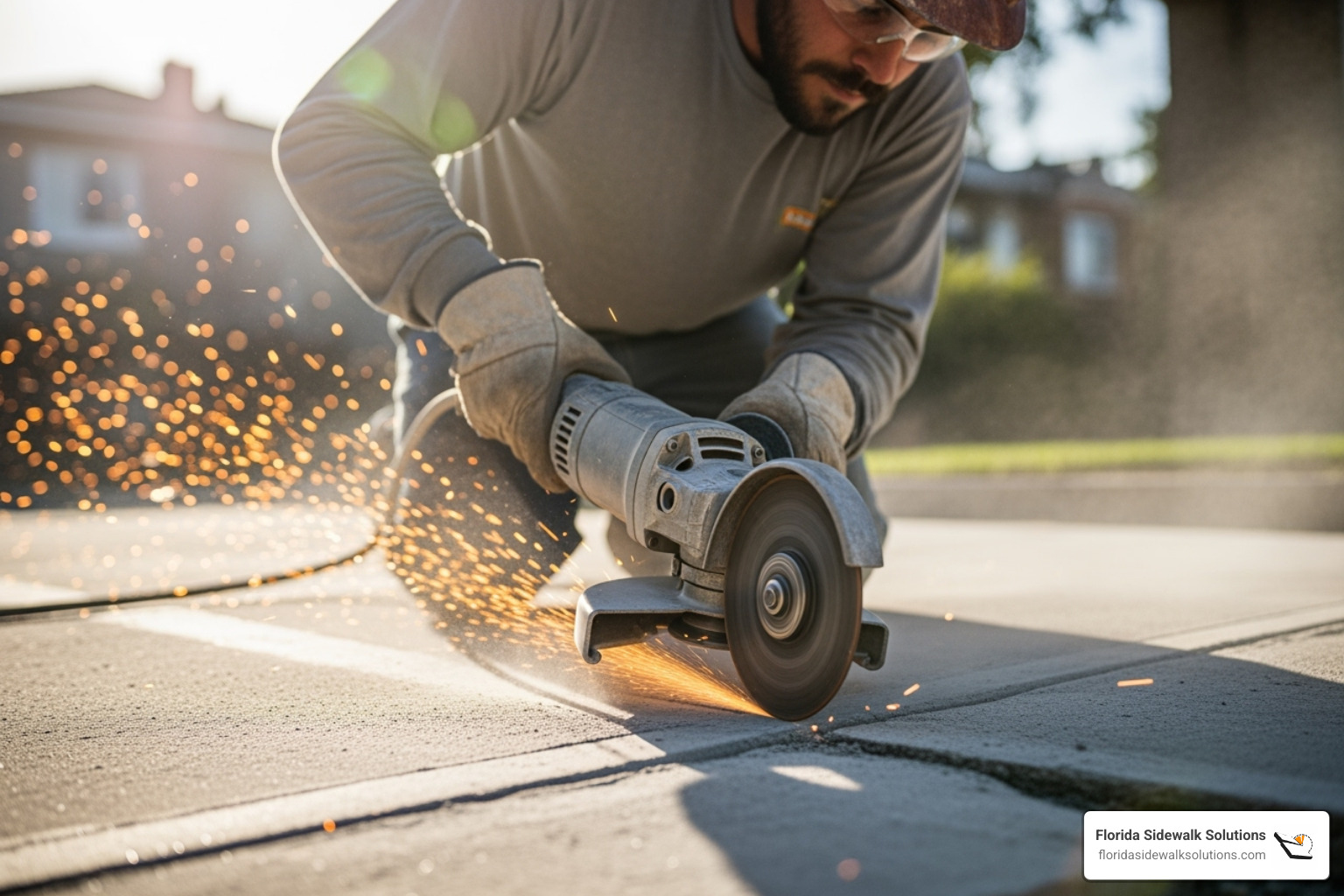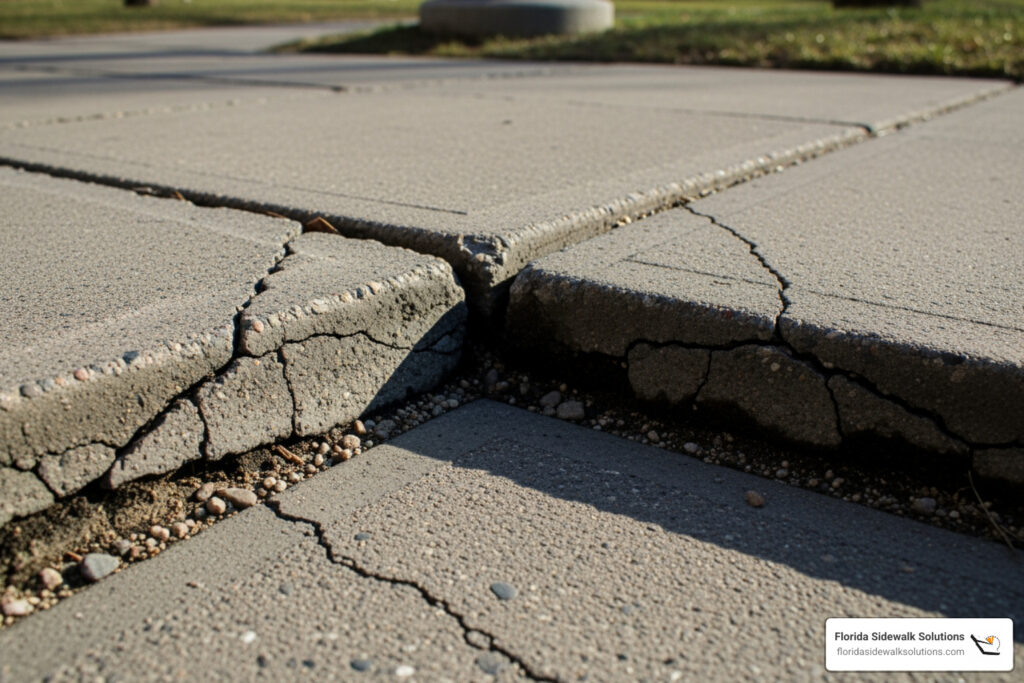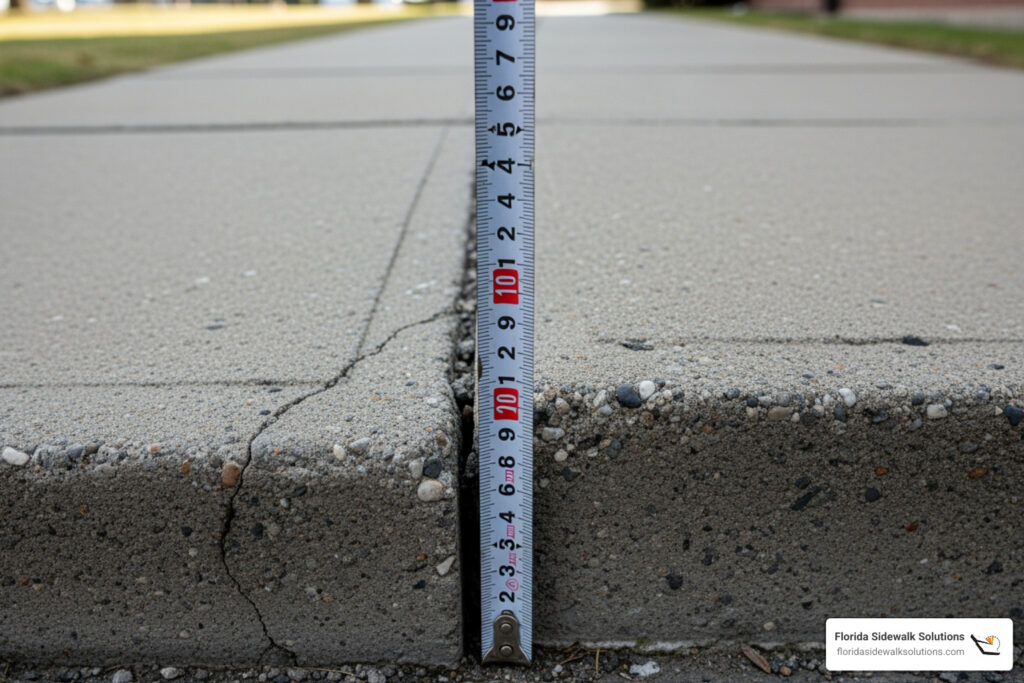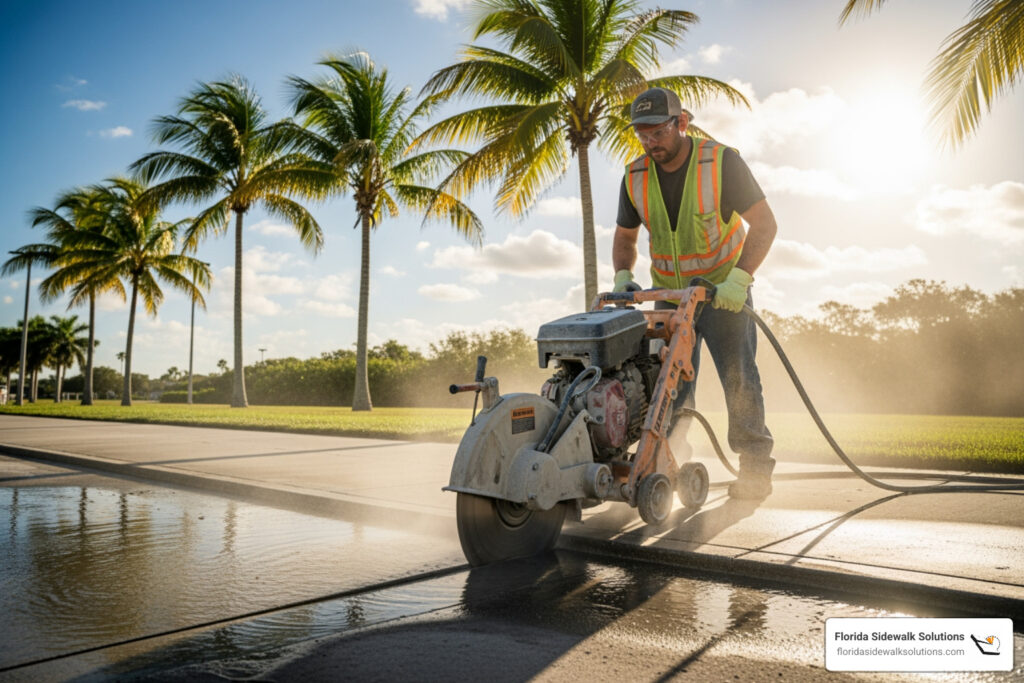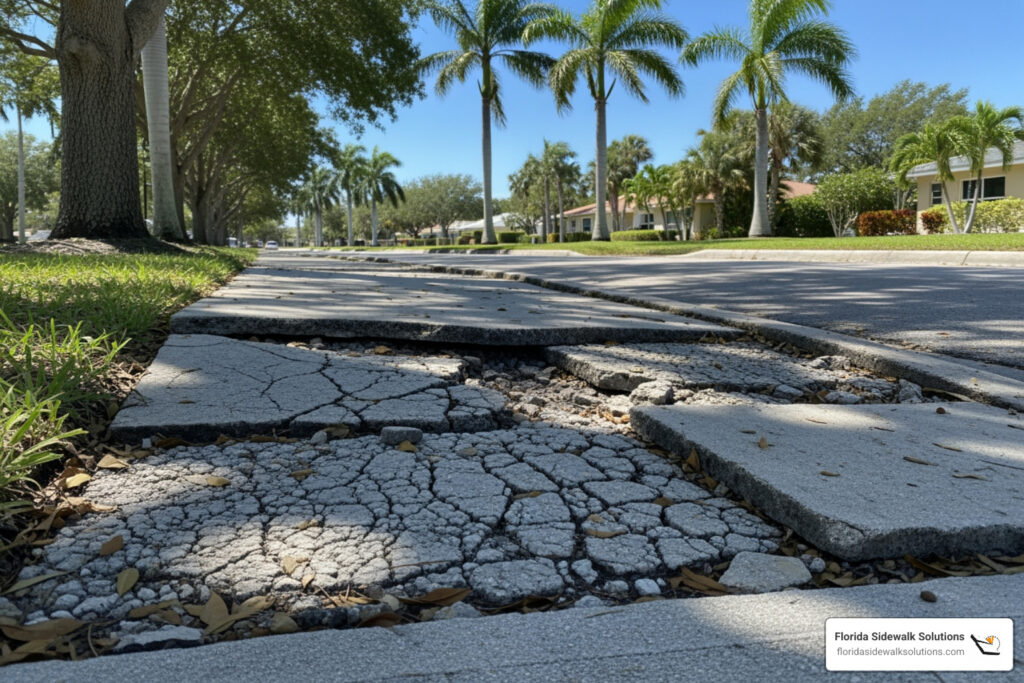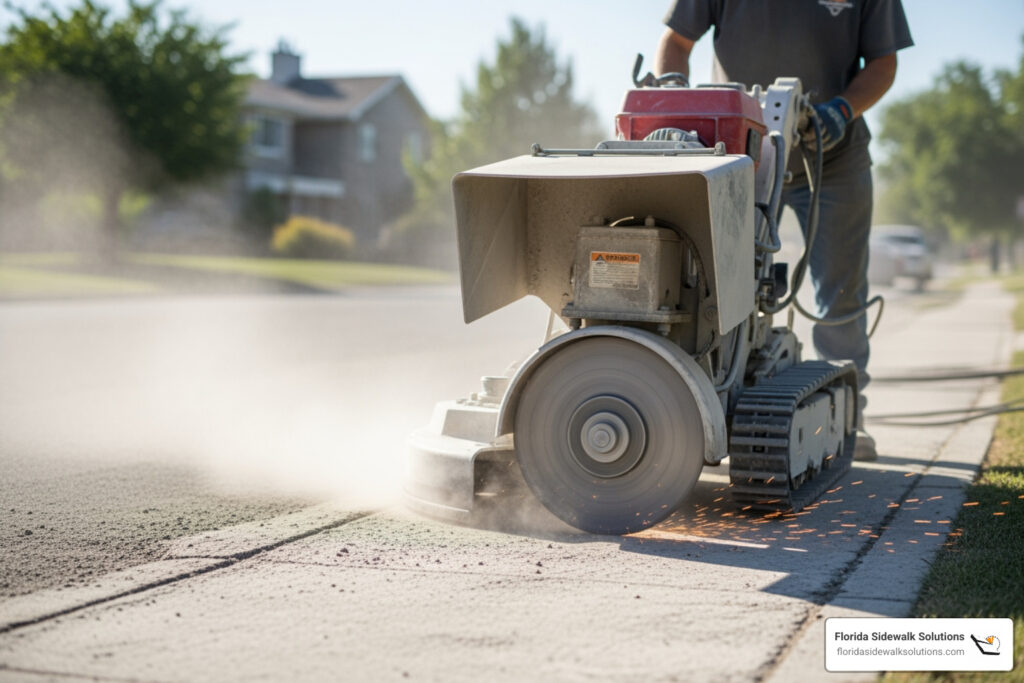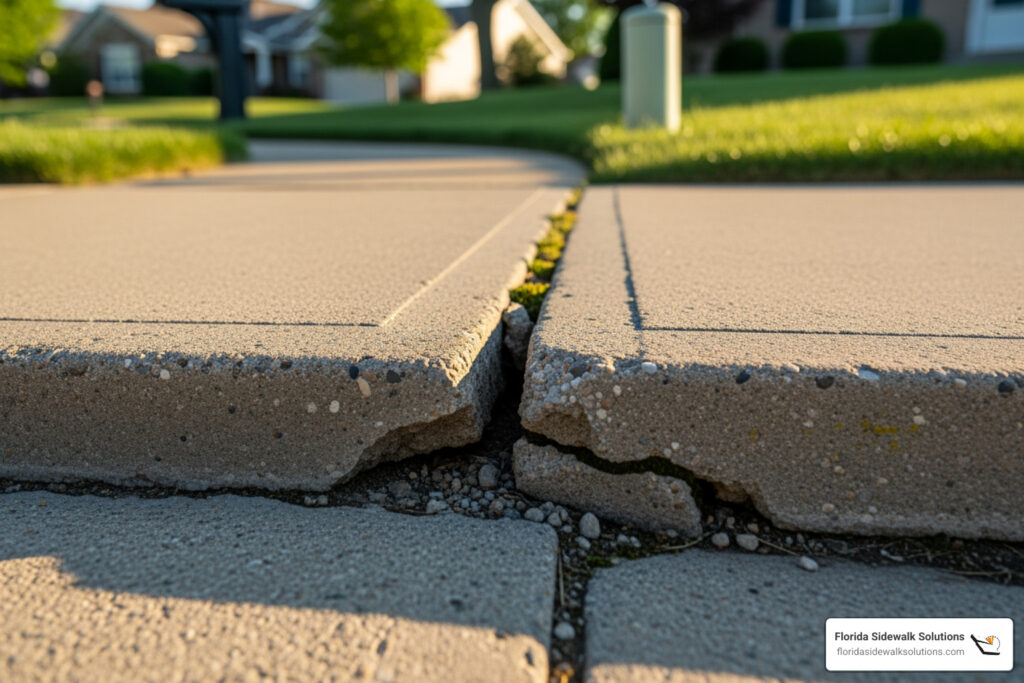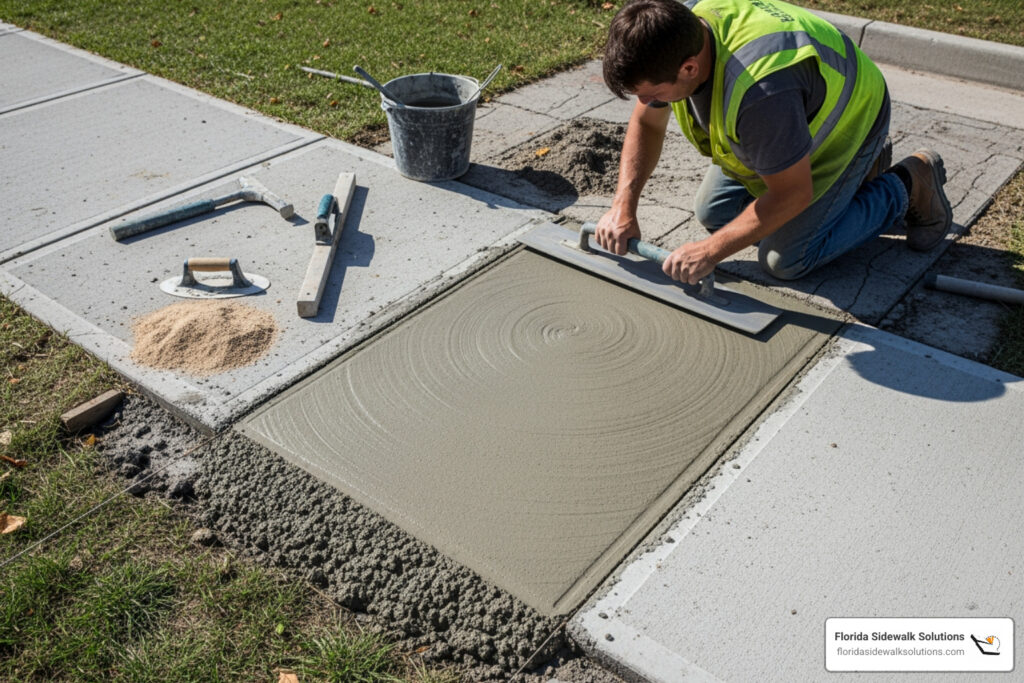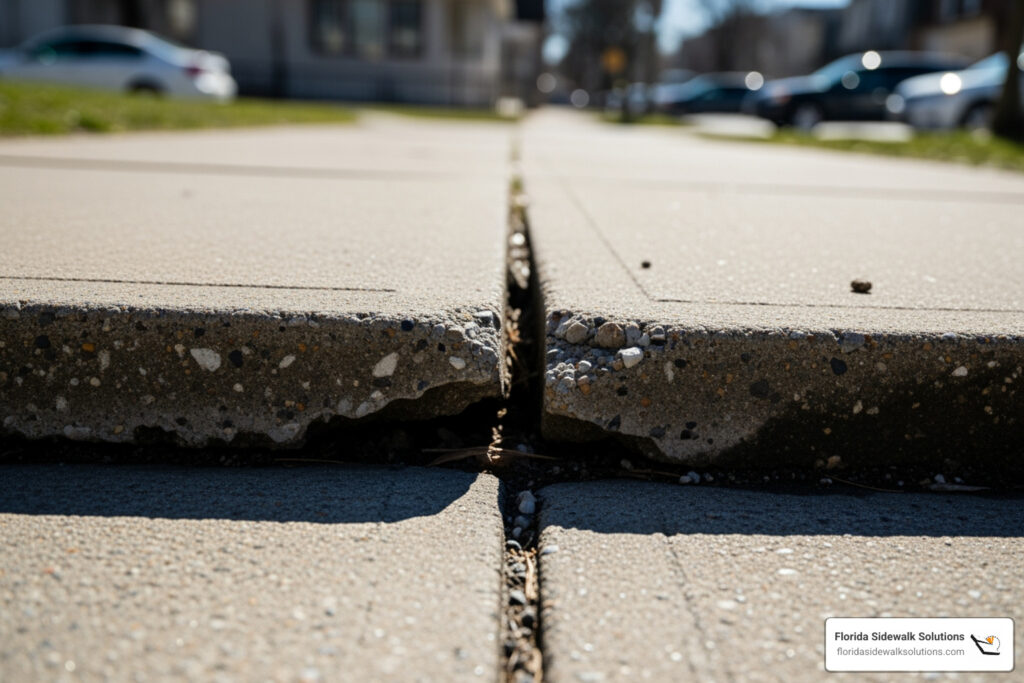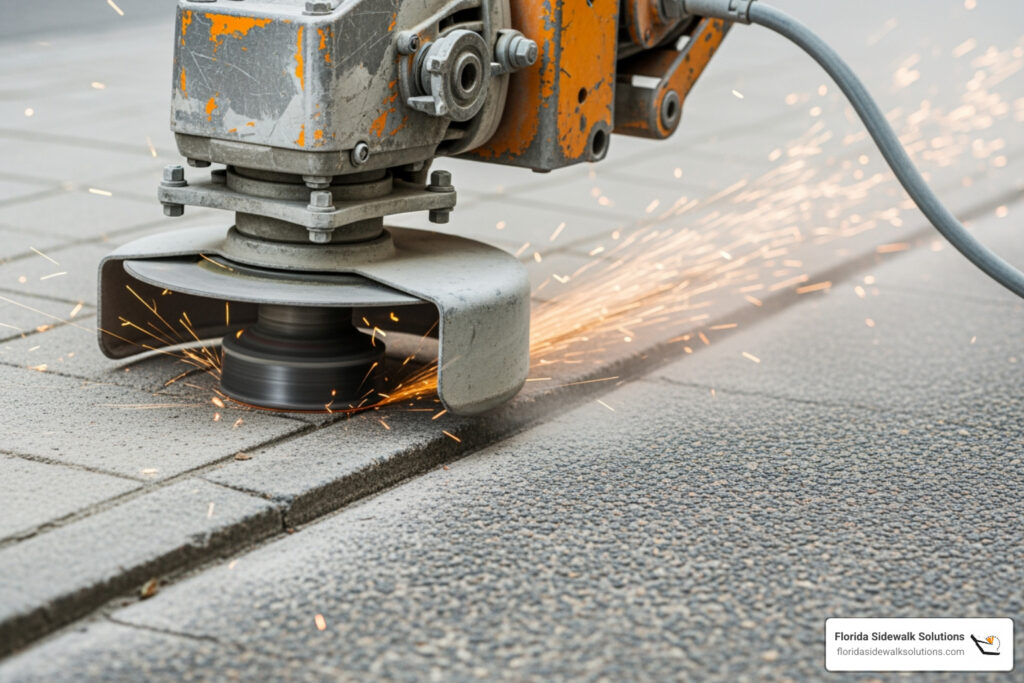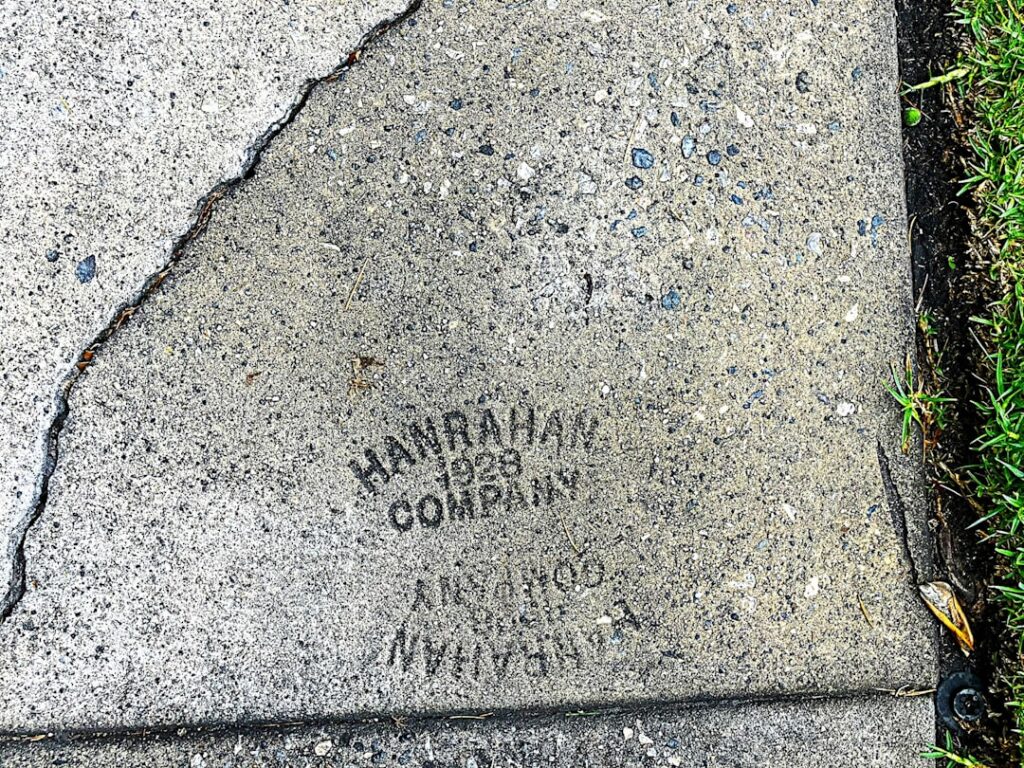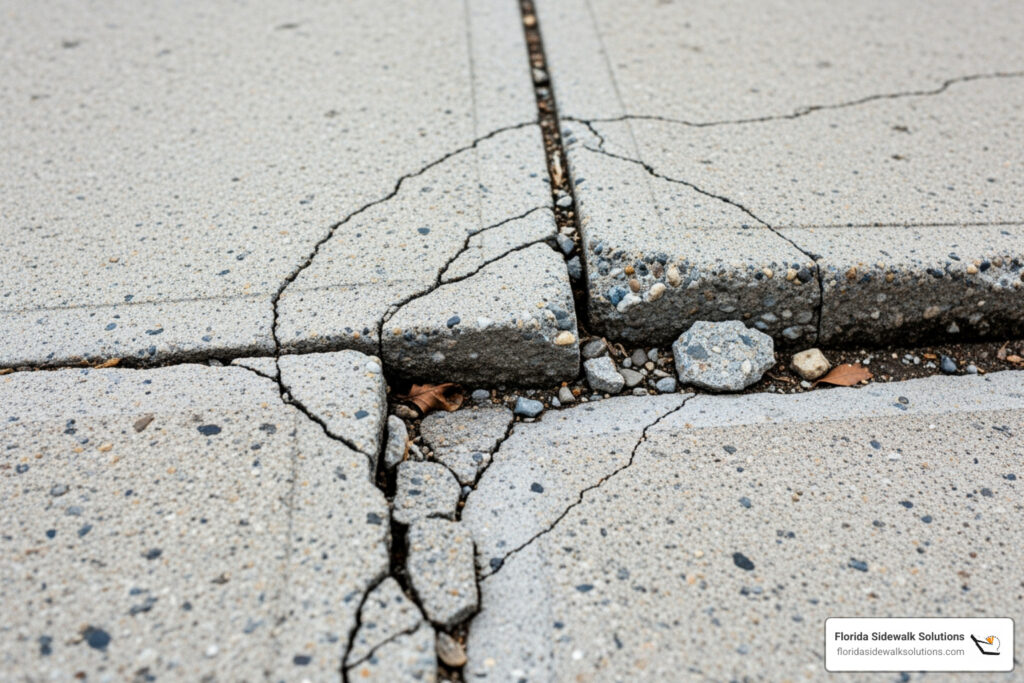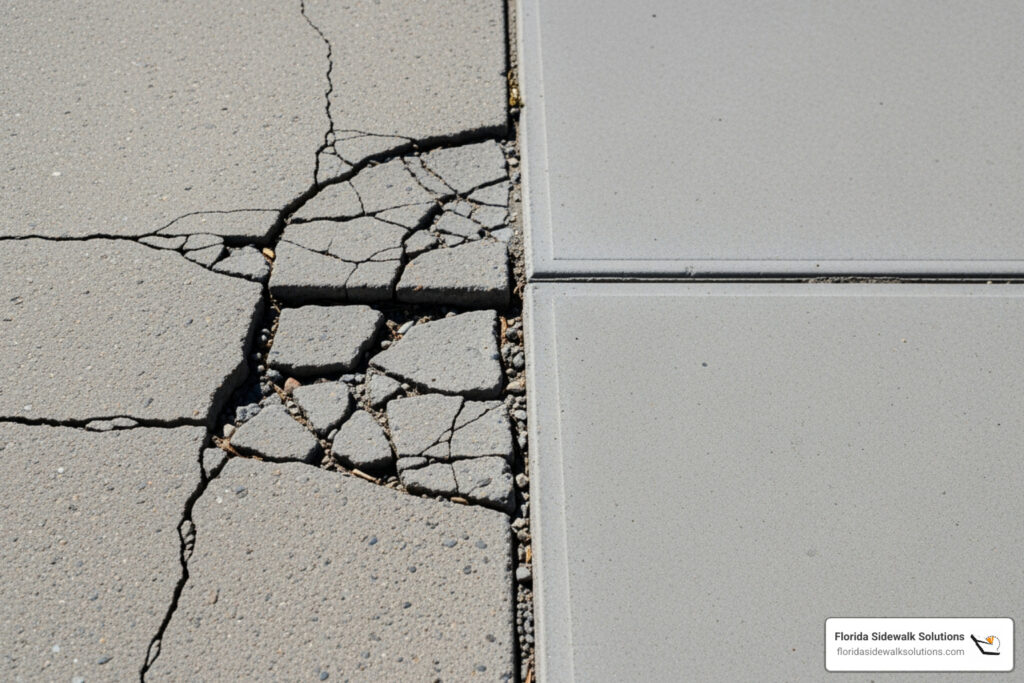Understanding Sidewalk Trip Hazards and Your Repair Options
Grinding cement sidewalk surfaces is one of several methods used to eliminate dangerous trip hazards, but it’s important to understand all your options before choosing a repair approach.
Quick Answer for Municipal Managers:
- What it is: Using specialized grinders to shave down raised concrete sections
- Cost: Generally 1/10 the cost of full replacement
- Limitations: Weakens concrete, creates scarring, often leaves trip hazards at edges
- ADA Compliance: Difficult to achieve precise slopes required by law
- Better Alternative: Precision concrete cutting creates cleaner, more durable repairs
Uneven sidewalks don’t just look bad – they’re a huge liability. According to Americans with Disabilities Act (ADA) guidelines, any vertical change over 1/4 inch creates a trip hazard that can result in costly lawsuits and injuries.
For municipal maintenance managers facing budget constraints, the pressure to find cost-effective solutions is real. Traditional concrete grinding might seem like the obvious choice since it’s less expensive than full replacement, but this approach often creates more problems than it solves.
The reality is that grinding typically:
- Leaves inconsistent results that don’t fully eliminate hazards
- Creates permanent scarring on your sidewalk assets
- Fails to achieve precise ADA-compliant slopes
- Weakens the concrete structure over time
While grinding can provide a temporary fix, many communities have finded that superior alternatives exist. Modern precision cutting methods offer cleaner results, better ADA compliance, and longer-lasting repairs – often at comparable or lower costs than traditional grinding.

Grinding cement sidewalk helpful reading:
What Causes Sidewalk Trip Hazards?
Before we dive into solutions, let’s understand why sidewalks become uneven in the first place. It’s not just random chance; there are several common culprits behind those pesky trip hazards.
One of the most frequent causes is soil settlement. Over time, the ground beneath concrete slabs can compact or wash away, creating voids. When the support underneath is gone, the slab can sink, leading to an uneven surface. Similarly, water erosion from leaky gutters, downspouts, or poor drainage can undermine the soil, washing away the crucial base supporting the sidewalk. This is why addressing drainage issues is an actionable step we always recommend.
Another major contributor, especially here in Florida, is invasive tree roots. As trees grow, their root systems expand, often pushing up concrete slabs from beneath. This can create significant height differences, sometimes several inches high, making a very obvious and dangerous trip hazard.
In colder climates, freeze-thaw cycles play a huge role. Concrete is porous, meaning it absorbs water. When this water freezes, it expands, putting immense pressure on the concrete. When it thaws, it contracts. This continuous expansion and contraction can cause the concrete to crack, heave, and break apart, leading to unevenness. While we don’t experience severe freezing here in Florida, understanding this mechanism helps illustrate how natural forces impact concrete.
Finally, poor sub-base preparation during the initial installation or concrete expansion due to heat can also contribute to unevenness. If the ground wasn’t properly compacted or if expansion joints weren’t installed correctly, the slabs are more prone to shifting and creating hazards.

Why Grinding Only Fixes the Symptom, Not the Cause
When we talk about grinding cement sidewalk surfaces, it’s crucial to understand a fundamental limitation: it’s almost always a surface-level repair. While it can temporarily eliminate the immediate trip hazard, it rarely addresses the underlying issues that caused the concrete to become uneven in the first place.
Think of it like this: if your car has a flat tire, patching the hole without finding the nail will only lead to another flat. Similarly, grinding down a raised slab just shaves off the top portion. It doesn’t fill the void beneath the concrete, stop the soil erosion, or remove the aggressive tree roots that are pushing it up.
Because the underlying problems remain, the potential for recurring issues is high. That slab that was ground down might settle further, or the adjacent slab might lift, creating a new trip hazard in the same spot or nearby. This makes grinding a short-term solution at best, and often a frustrating cycle of repeated repairs. We’ve seen ground-down concrete suffer from damage because the root cause was never fixed. It’s a bit like putting a band-aid on a broken bone – it might look okay for a moment, but the fundamental problem is still there.
More info about concrete sidewalk repair
The DIY Approach to Grinding Cement Sidewalk Hazards
We’re going to walk you through the DIY world of grinding cement sidewalk hazards, but here’s the thing – we need to be completely honest with you upfront. While we’ll share this information for educational purposes, attempting concrete grinding yourself comes with some pretty serious risks and downsides that most homeowners don’t anticipate.
Think of it like performing surgery on your own appendix. You could watch YouTube videos and buy the tools, but there’s a reason professionals exist. The same logic applies here, especially when you’re dealing with ADA compliance requirements and potential liability issues.

Tools and Safety Equipment Needed for Grinding
If you’re still determined to tackle grinding cement sidewalk surfaces yourself, let’s talk about what you’re getting into. The tool list alone might make you reconsider – and that’s before we even discuss the safety gear that could literally save your life.
Your main weapon will be an angle grinder with enough muscle to handle concrete – we’re talking 10-15 amps minimum. You’ll need a diamond cup wheel attachment because regular grinding wheels just won’t cut it (pun intended). Different grits will give you different results, from aggressive material removal to smoother finishes.
Here’s where things get serious: the dust shroud attachment and HEPA-filter vacuum aren’t optional extras. Concrete dust contains crystalline silica, and breathing that stuff is like inviting lung disease to move in permanently. A regular shop vac won’t protect you – you need that HEPA filter to catch the microscopic particles that can wreck your respiratory system.
Your personal protective equipment becomes your lifeline. Safety glasses or goggles protect against flying debris, while an N95 or P100 respirator mask is absolutely non-negotiable for lung protection. Don’t even think about using a simple dust mask – it’s like bringing a water gun to a fire fight. Heavy-duty gloves shield your hands from vibrations and potential burns, hearing protection saves your eardrums from the grinder’s screaming, and knee pads will thank you after hours of kneeling work.
A Step-by-Step Guide to Grinding Cement Sidewalk Panels
Ready for the actual grinding process? Buckle up – this is where patience meets precision, and there’s zero room for “close enough.”
Start by assessing the height difference with a straightedge and measuring tape. Most municipalities won’t let you grind more than an inch of material, and honestly, that’s probably wise. For every half-inch of rise, you’ll need to grind back about six inches to create a proper slope. Do the math before you start – it’s more work than most people expect.
Mark your grinding area with chalk so you don’t accidentally turn your sidewalk into abstract art. Clear away all debris and give the surface a good cleaning. You want to start with a clean slate, literally.
Once your dust shroud and vacuum are connected (seriously, don’t skip this step), begin grinding at the highest point of the raised slab. Keep that grinder moving in smooth, sweeping motions – parking it in one spot will create gouges that look terrible and can actually make things worse.
The key is creating a smooth, sloped transition that eliminates the trip hazard without creating a new one. Stop frequently to check your progress with a straightedge. You’re aiming for what professionals call a “zero point of differential” – basically, no abrupt height changes that could catch someone’s toe.
Finish with a finer grit wheel to smooth things out, then clean up all dust and debris thoroughly. Consider applying a concrete sealer to protect your work and improve the appearance.
More info about trip hazard removal specialists
Critical Safety Precautions and Risks
Let’s have a serious conversation about why grinding cement sidewalk surfaces isn’t a casual weekend project. The biggest threat isn’t obvious – it’s the crystalline silica dust you can’t see that can cause irreversible lung damage, including silicosis, lung cancer, and COPD. This isn’t scare tactics; it’s medical fact.
Tool kickback is another real danger. When a powerful angle grinder catches an edge unexpectedly, it can violently jerk out of your hands, potentially causing severe injury. We’ve seen experienced contractors get hurt when they got careless for just a moment.
Don’t forget about electrical safety either. You’re using high-powered tools, often outdoors, sometimes around moisture. Make sure your extension cords are outdoor-rated and your power source has GFCI protection. Getting shocked while holding a spinning grinder is nobody’s idea of a good time.
According to municipal repair standards, ground surfaces must meet specific slip resistance requirements – a Coefficient of Friction of 0.5 or above. Most DIYers have no way to test this, which means you could create a slipping hazard while trying to fix a tripping hazard.
A municipal guide to sidewalk repair standards
The bottom line? While we’ve given you the roadmap, the risks and technical challenges of achieving proper ADA compliance make professional assessment and repair the smarter choice for lasting, safe results.
Why Grinding Is Often a Flawed Solution
Here’s the uncomfortable truth about grinding cement sidewalk surfaces: while it might seem like a practical fix, it often creates more problems than it solves. After years of seeing the aftermath of grinding jobs, we’ve learned that this approach frequently leaves property owners disappointed and still dealing with safety concerns.

The Downsides of Grinding Concrete
Let’s talk honestly about what happens when you choose grinding for your trip hazard repair. The reality is far less appealing than the initial cost savings might suggest.
Grinding weakens the concrete slab in a fundamental way. Every pass of that grinder removes precious material, making your sidewalk thinner and more vulnerable to cracking. Think of it like filing down a fingernail too far – what’s left just isn’t as strong. This weakened concrete becomes a magnet for future problems, especially when Florida’s weather throws everything from intense heat to sudden downpours at it.
The process also exposes aggregate beneath the surface layer. Those rough stones and gravel pieces that were safely tucked inside the concrete are now right at the surface, creating an uneven texture that’s uncomfortable to walk on. Even worse, this rough surface can actually reduce slip resistance, making your sidewalk more dangerous than before.
But here’s what really gets us: grinding creates an unsightly scar that never goes away. That ground area will always look different from the surrounding concrete – lighter in color, rougher in texture, and obviously patched. It’s like putting a bandage on your sidewalk that never comes off.
Most importantly, grinding doesn’t address the root cause of the problem. If tree roots pushed up your concrete, they’re still there. If soil settled beneath the slab, that void remains. This means you’re likely looking at the same problem again in a few years, turning what seemed like a one-time fix into an ongoing expense.
When it comes to ADA compliance for sidewalks, grinding often falls short. Achieving those precise, gradual slopes required by law is incredibly difficult with a grinder. The tool simply doesn’t offer the accuracy needed to create consistently compliant transitions, potentially leaving you with liability issues even after spending money on repairs.
More info on the disadvantages of concrete grinding
Aesthetics and Property Value
Your sidewalk is often the first thing people notice about your property. It sets the tone before visitors even reach your front door or customers enter your business. Unfortunately, grinding cement sidewalk surfaces rarely does your curb appeal any favors.
The mismatched appearance is perhaps the most obvious problem. Ground concrete looks different – period. It’s lighter, rougher, and clearly artificial compared to the smooth, uniform surface around it. This permanent scarring on the concrete doesn’t fade or blend in over time. If anything, it becomes more noticeable as weather and wear highlight the difference in texture and color.
For property owners, this aesthetic damage can detract from curb appeal in a significant way. Instead of a clean, welcoming walkway, you’re left with what looks like a patchwork quilt of repairs. Potential buyers or customers notice these details, and they don’t typically interpret visible repairs as a sign of good maintenance.
Precision cutting offers a cleaner look because it creates uniform, beveled edges that integrate seamlessly with existing concrete. Rather than grinding away material and creating scars, precision cutting removes just enough concrete to eliminate the hazard while maintaining the sidewalk’s structural integrity and appearance.
The difference is night and day – and your property value will reflect that difference.
A Superior Alternative: Florida Sidewalk Solutions’ Precision Concrete Cutting
After seeing the limitations of grinding cement sidewalk surfaces firsthand, we developed something much better. At Florida Sidewalk Solutions, we’ve pioneered a precision concrete cutting method that solves trip hazards without the headaches, scarring, and recurring problems that come with traditional grinding.
We get it – you need cost-effective solutions that actually work. That’s exactly why we created our approach. We believe in doing the job right the first time, ensuring safety, longevity, and results that actually look good when we’re done.

What is Precision Concrete Cutting?
Our patented technology represents a completely different approach to sidewalk trip hazard removal. Instead of grinding away material randomly and hoping for the best, we precisely cut the concrete to remove trip hazards with surgical accuracy. The result? A clean, uniform, beveled edge that looks like it was always meant to be there.
Here’s what makes our method special: we maintain the structural integrity of your concrete slab. We don’t thin out entire sections or weaken the concrete like grinding does. Instead, we create a safe, gradual transition exactly where the trip hazard existed. Your concrete stays strong and durable, which means fewer headaches down the road.
The cost-effectiveness is another huge advantage. Grinding might look cheaper on paper, but those limitations we talked about earlier add up fast. Repeated repairs, liability issues, and poor aesthetics that hurt property values – it all costs money. Our precision cutting offers a lasting solution that actually saves you money by avoiding these problems entirely.
Our advanced equipment can reach edges and tight spots that grinders simply can’t handle effectively. We can remove trip hazards from virtually any angle and location, creating that clean-cut, safe walking path at a fraction of the cost of full replacement.
Learn about our patented sidewalk repair technology
Grinding vs. Precision Cutting for Sidewalk Repair
Let’s put grinding cement sidewalk surfaces side by side with our precision concrete cutting method. The differences are pretty dramatic:
| Factor | Grinding | Precision Concrete Cutting (Our Method) |
|---|---|---|
| Final Appearance | Scarred, discolored, rough, mismatched patch | Clean, uniform, beveled edge, seamless blend |
| ADA Compliance | Difficult to achieve precise, consistent slopes; often leaves non-compliant areas | Achieves precise, ADA-compliant slope (1:12 or less) |
| Structural Impact | Thins and weakens concrete slab; exposes aggregate | Maintains structural integrity; only removes necessary material for slope |
| Longevity | Short-term fix; prone to recurring issues; limited lifespan | Long-lasting solution; addresses hazard effectively; durable |
| Cost-Effectiveness | Appears cheap upfront, but can lead to re-work, repeated repairs, and liability issues | Highly cost-effective long-term; avoids re-work and liability; often less expensive than replacement |
The reality is that grinding often can’t even reach the edges of sidewalks properly or grind the concrete truly level with the next panel. This means trip hazards frequently remain, just in slightly different spots. Our method takes very little time, causes minimal disruption to foot traffic, and delivers that safe, clean-cut walking path you actually want.
Why Cutting is the Best Method for ADA Compliance
When it comes to ADA compliance, there’s no room for “close enough.” The Americans with Disabilities Act defines a trip hazard as any vertical change of 1/4 inch or more. This isn’t just a suggestion – it’s federal law, and non-compliance creates serious legal liability.
Our precision concrete cutting method was specifically designed to achieve precise, compliant slopes every single time. While grinding leaves you guessing about whether you’ve actually achieved compliance, our cutting technology creates clean, consistent bevels that meet the required ADA standards without question.
This precision is why municipalities and property managers increasingly choose our method over grinding. It’s not just about fixing a visible problem – it’s about eliminating liability, ensuring true accessibility, and demonstrating a real commitment to public safety. When you use our cutting method, you can sleep easy knowing your sidewalks aren’t just safer, but fully compliant with federal accessibility laws.
The safe, predictable surface we create works for everyone – from wheelchair users to parents with strollers to elderly pedestrians who need that extra confidence in their footing.
Learn how to fix trip hazards for ADA compliance
Frequently Asked Questions about Sidewalk Repair
We hear these questions all the time from property owners and municipal managers dealing with sidewalk trip hazards. Let’s clear up some of the most common concerns about sidewalk repair methods and responsibilities.
How much of a height difference is considered a trip hazard?
Here’s the simple answer: any vertical change over 1/4 inch creates a potential trip hazard and violates ADA guidelines. This isn’t just a suggestion – it’s a legal standard that can make you liable for injuries.
Now, we know some local codes might allow up to 1/2 inch, but honestly? Don’t risk it. Sticking to the 1/4 inch rule keeps you on the safe side legally and ensures maximum safety for everyone walking on your sidewalks. Whether it’s a senior citizen with a walker or a parent pushing a stroller, that extra safety margin matters.
The ADA didn’t pick this number randomly – it’s based on real research about what causes people to trip and fall. When you’re dealing with public walkways, it’s always better to err on the side of caution.
Can you grind a sidewalk more than once?
Technically, yes, but we strongly advise against it. Here’s why: every time you’re grinding cement sidewalk surfaces, you’re essentially making the concrete thinner and weaker. It’s like repeatedly sanding down a piece of wood – eventually, you’re going to compromise its strength.
Each grinding session removes more material, exposing more aggregate and creating a weaker structure. The concrete becomes much more susceptible to cracking, breaking, and weather damage. We’ve seen sidewalks that were ground multiple times literally fall apart within a year or two.
Plus, the aesthetic problems get worse with each grinding. That scar we talked about earlier? It just gets bigger and more obvious. Eventually, you’ll need full replacement anyway – and that’s going to cost you way more than doing it right the first time.
This is exactly why our precision cutting method makes so much more sense. It removes just enough material to create a safe, ADA-compliant slope without weakening the overall structure.
Who is responsible for repairing the sidewalk in front of my house?
This one surprises a lot of homeowners, but here’s the reality: in most Florida municipalities and across the country, you – the adjacent property owner – are responsible for maintaining the sidewalk in front of your property.
That means if someone trips on an uneven sidewalk panel in front of your house and gets hurt, you could be held liable for their injuries. We’re talking about potential lawsuits, medical bills, and significant financial responsibility. It doesn’t matter that it’s technically a “public” sidewalk – the maintenance responsibility typically falls on the property owner.
This responsibility isn’t unique to Florida either. Most cities and municipalities across the United States have similar ordinances that make property owners responsible for sidewalk maintenance. It’s one of those “fine print” aspects of property ownership that many people don’t realize until they face a problem.
The good news? Being proactive about sidewalk maintenance is much less expensive than dealing with a lawsuit or having to do emergency repairs after someone gets injured. Regular inspections and prompt repairs when you notice trip hazards developing can save you thousands of dollars and a lot of headaches down the road.
Conclusion: Choose the Right Repair for a Lasting Solution
Let’s be honest: when you’re staring at a dangerous sidewalk trip hazard, grinding cement sidewalk surfaces might seem like the obvious choice. It’s cheaper upfront, and hey, it gets the job done, right? Well, not exactly.
After walking you through all the ins and outs of concrete grinding, we hope one thing is crystal clear: grinding is really just putting a band-aid on a broken bone. It might look better for a while, but you’re dealing with some serious drawbacks that can come back to bite you.
The reality of grinding’s significant drawbacks is hard to ignore. You’re weakening your concrete with every pass of that grinder, creating structural weakness that makes future problems almost inevitable. And let’s talk about those poor aesthetics – that permanent scar running across your sidewalk isn’t exactly winning any beauty contests. It’s like having a patch on your favorite jeans that’s a completely different color.
But here’s where things get exciting. The benefits of precision cutting are game-changing. Our patented technology doesn’t just mask the problem – it actually solves it. You get a safer, more durable, and ADA-compliant result that looks clean, professional, and seamless. No ugly scars, no weakened concrete, and most importantly, no liability headaches keeping you up at night.
At Florida Sidewalk Solutions, we’ve seen too many properties struggle with the cycle of grinding, re-grinding, and eventually having to replace entire sections anyway. Why go through all that hassle when you can get it right the first time?
If you’re ready to stop putting band-aids on your sidewalk problems and want a professional assessment for a permanent fix, we’d love to help. Our precision cutting method eliminates trip hazards completely while keeping your sidewalks looking great and staying ADA-compliant for years to come.
Contact us for professional sidewalk repair in South Florida

